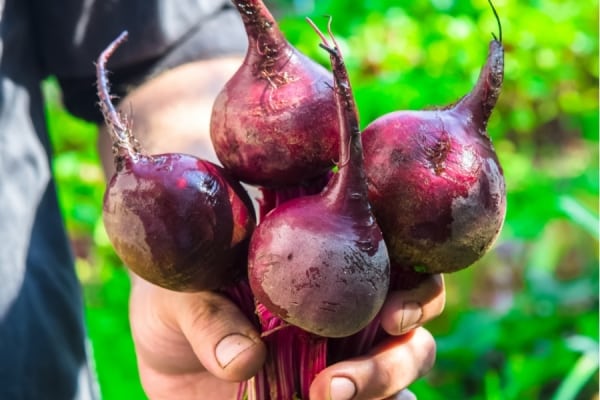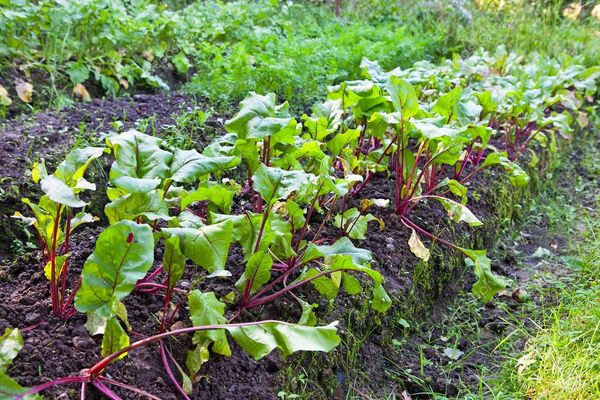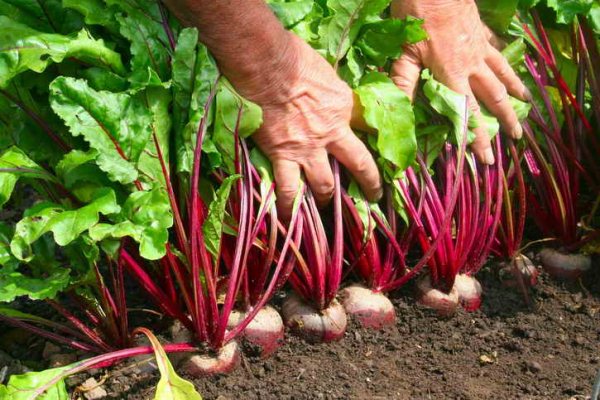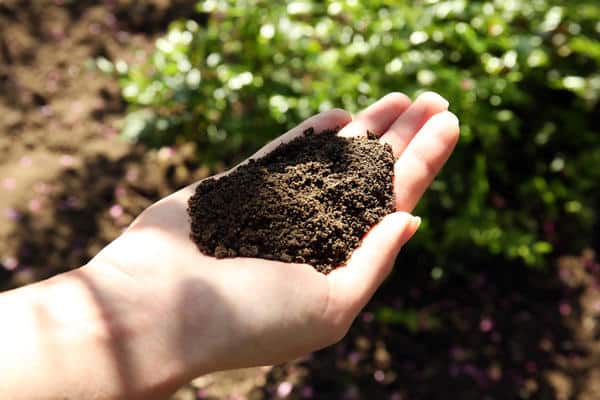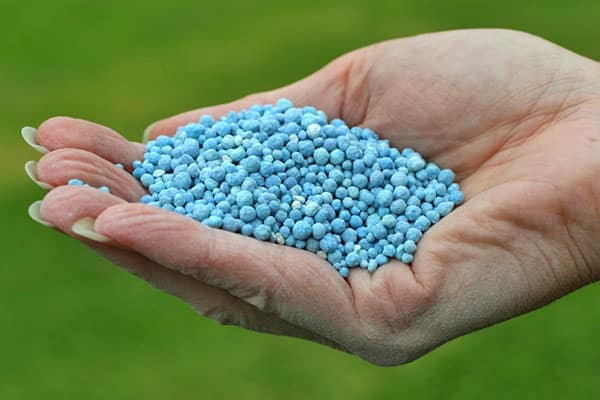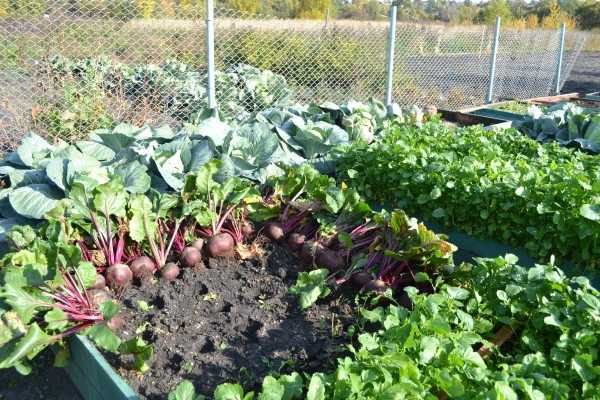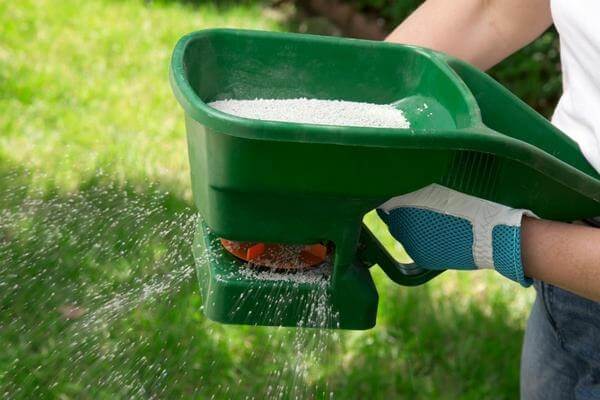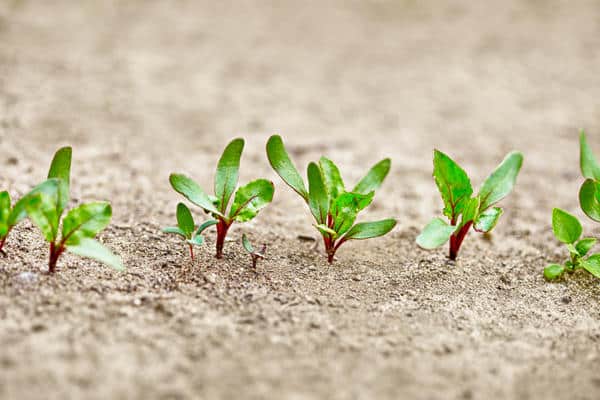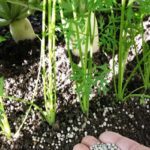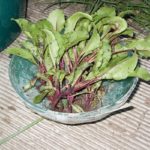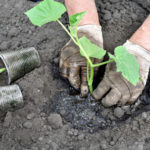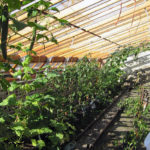Planting beets with seeds in open ground can be done in different ways in spring or autumn. The vegetable is easy to grow; you just need to observe certain conditions when planting and caring for it. In this case, the harvested crop will be stored for a long time, and the root crops will retain all their nutritional elements.
Beet varieties for growing in open ground
Varieties differ in terms of harvest ripening, storage duration of collected root crops, color, shape, and intended purpose.In the latter case, the vegetable can be sugar, fodder or table.
To popular beet varieties for cultivation include the following:
- Beetroot Detroit It is characterized by high yield and excellent taste. It takes 100 days from sowing to harvest. The variety is resistant to frost and disease, seedlings appear evenly and are unpretentious during cultivation. The shape of the root crop is round, the flesh is burgundy without rings or veins. The average weight of the root crop is 200 g.
- The mid-season table variety Cylinder belongs to the mid-season, productive varieties. Harvesting begins after 120 days. The shape of the root vegetables is cylindrical, the flesh is dark red. The average weight of beets is 30 g. The harvested crop is well stored for more than 4 months.
- The productive, mid-season variety Smuglyanka begins to ripen after 105 days. The plant tolerates cold well and is resistant to cold and disease. The root crop is flat-round in shape, weighs 300 g. The pulp is juicy and bright red.
- Bordeaux beets are table varieties. The shape of the root crop is round, slightly flattened. Vegetable weight 350 g. The pulp is juicy, rich burgundy color. Productivity depends on the weather. The vegetable develops poorly in cold and rainy summers.
Other popular beet varieties include: Kupchikha, Krasny Shar, Boyarynya, Red Ruby, Bohemia, Red Ice, Pablo.
Landing dates
Seeds are planted in open ground in the spring in early May, when the soil warms up to +10 degrees. The last date for planting beets is no later than May 10.
In the fall, the last days of October or the first days of November are chosen for planting seed material in open ground. It is better to wait until the air temperature drops below -4 degrees.In warmer weather, this should not be done, as the seeds will pierce and die.
During the autumn planting of seeds, the beds are made high, raised by 25 cm, so as not to be washed away by melt water. The depth of the furrows is 4 cm; they do not need to be watered before planting. To protect the seeds from frost, it is recommended to cover the beds with straw until spring.
If beets are planned to be planted through seedlings, then special boxes are prepared. Seeds for seedlings begin to be planted in early April, a month before transplanting to a permanent place. This method of planting allows you to harvest ahead of schedule. In addition, the sprouts remaining from thinning can be transplanted to free space.
Seeds should be planted at a distance of 4 cm, the distance between rows should be 6 cm. After two leaves develop on the sprouts, thinning is carried out. Only strong and healthy shoots are left. As soon as 4 leaves appear, the sprouts will be ready to be transplanted to a permanent location.
Choosing a place in the garden
It is best to choose areas for planting beets that are protected from draft winds and where sunlight freely penetrates. The soil should be well-drained; the vegetable does not tolerate clay and waterlogging. It is advisable to change the planting site every 3–4 years.
There is a list of crops, after which it is allowed to plant beets. The best predecessors for beets in the garden are cucumbers, onions, tomatoes, and potatoes. A vegetable feels bad in a garden bed where cabbage, chard or carrots used to grow. Avoid proximity to celery and garlic.
Lighting
Beetroot is a light-loving vegetable crop. Grows well during long sunny days.If the length of the day when growing a vegetable is 14–16 hours, then you can reap the richest possible harvest. If daylight hours are reduced by 3 hours or more, the formation of root crops slows down.
To plant beets in open ground in the spring, you need to choose well-lit areas, away from fences and trees, so that they do not cast shadows. Don't plant the vegetable too thickly.
Sometimes vegetable growers may encounter a problem when beets do not sprout.
Before determining what to do, you need to find out the reason why it did not sprout. There may be several of them:
- infertile or acidic soil;
- little light;
- low-quality seeds;
- improper watering;
- non-compliance with sowing deadlines.
To ensure good germination of beets, you need to apply fertilizer and use lamps for additional illumination. If the vegetable is grown as seedlings, then, if necessary, additional illumination is provided for up to 13 hours with fluorescent lamps, which are suspended at a height of 15 cm above the seedlings.
A good harvest can only be obtained if important conditions are met. It is necessary to feed the beds on time, remove weeds, monitor lighting and watering. It is important to carry out preventive treatment against pests and diseases.
What kind of soil does beets like?
To get a good harvest of root crops, it is important to know what kind of soil does beets like best? Beets love fertile, light soil. Peat and loamy composition is well suited. If the acidity is too low or too high, the vegetable begins to suffer from fungal diseases, and the ability to be stored for a long time is lost.
Since the vegetable loves light, well-drained soil, it is better to mix it with sand or sawdust. If the soil has high acidity, then liming is carried out. The culture loves neutral or slightly alkaline soil.
Sowing root crops in open ground
Sowing beets can be done with dry or germinated seeds. Germinated seeds are sown in moist soil. On the flat surface of the prepared area, make furrows at a distance of 20 cm.
If the soil is heavy, then sowing is done to a depth of 2 cm; if it is light, then to a depth of 4 cm. The distance in the row between the seeds is 2.5 cm. Later, during thinning, the distance should be increased to 7 cm.
If the summer is short, then beet seedlings are planted in open ground. You can grow seedlings at home or in a greenhouse. You can replant a plant that does not exceed 8 cm in height. The higher the sprout, the poorer the root crop will be formed. Do not deepen the seedlings too much. The distance between sprouts is 13 cm, between rows - 30 cm.
Soil preparation
In order for beets to sprout quickly, you need to properly prepare the land. The soil for planting seeds needs to be prepared in the fall. All plant residues from the previous harvest (tops, leaves, roots, weeds) are removed from the area where beets are supposed to be planted. The soil is dug up to a depth of 25–30 cm, and complex mineral fertilizer and humus are applied at the same time.
In the spring, before planting seeds or seedlings, the land is loosened to a depth of 10 cm and leveled with a rake.
It is recommended to add mineral components. During the entire growing season, the crop requires nitrogen and potassium-phosphorus fertilizer. Beetroot responds well to tillage with wood ash and does not tolerate fresh manure at all.
Seed preparation
When preparing beet seeds for sowing, they are sorted and soaked in solutions that stimulate plant growth. You can place the seeds in a solution based on wood ash. Ash allows you to saturate the seed material with all the necessary mineral components.
It is also recommended to carry out a disinfection procedure.
A simple way to quickly germinate beet seeds:
- the seeds are soaked in water at room temperature (the seeds that float to the surface should be discarded);
- the water is drained and placed in a solution of Epin or Zircon for 4 hours;
- After this, the seeds are placed in a warm place for a day.
These actions will help the seeds swell and hatch. After this, you can start planting the seeds.
Planting process
There are two beet planting schemes - one-line and two-line. Planting in a three-line manner is also allowed. This makes caring for the plant easier. It is more convenient to water, loosen and weed the beds.
In the case of planting using the single-line method, furrows are made into which the seeds are placed at a distance of 10 cm. The interval between furrows is 45 cm.
With a two-line option for planting vegetables, make two furrows at a distance of 25 cm, then leave a free space of 50 cm. A similar pattern is alternated several times.
Beet seedlings in open ground are planted at intervals of 11–14 cm. The interval between rows is 25 cm. This will allow you to collect large root crops while maintaining the benefits and juiciness of the pulp.
Rules of care
Beets begin to germinate at a soil temperature of +9 degrees and ambient air temperature of +7 degrees. But active development is observed at an air temperature of +20 degrees. How many days does it take for beets to sprout after sowing? The first shoots appear on days 6–8.
Beet care is to follow some rules:
- the beds must be weeded regularly and weeds must not be allowed to grow;
- carry out regular loosening of the soil to ensure free access of oxygen and nutrients;
- it is recommended to apply fertilizers;
- It is important to set the correct watering regime.
The first loosening is carried out 5 days after the appearance of the first shoots. Initially, the loosening depth is 3 cm, gradually, as the plant grows, it can be increased to 7 cm.
Top dressing
Fertilizing is carried out at least twice during the entire growing season of beet development. Fertilizers help increase the plant's resistance to diseases and pests.
The following solutions help for the normal development of the culture. When planting seedlings in the ground, it is recommended to add a tablespoon of wood ash to 1 hole.
During the first feeding, you can add nitroammophoska or a mixture of sodium nitrate, superphosphate and potassium chloride. If there is a deficiency of nutrients in the soil, you can add a solution of mullein or bird droppings. Urea can be added to the solution. Fertilizing with organic solutions is carried out only at the early stage of plant development.
The second application of fertilizers is carried out two weeks after the previous feeding. Use superphosphate or potassium chloride. Mineral components can be replaced with wood ash.
It is also useful to carry out foliar feeding. At the stage of formation of 4-5 leaves, you can treat with a solution of boric acid or an infusion of wood ash. If there is a lack of phosphorus, you can carry out additional spraying with superphosphate (take a teaspoon of superphosphate per liter of water).
Proper watering
When growing crops, you need to follow the correct watering regime. Beets need to be watered regularly, but avoid overmoistening the soil. Excess moisture causes various diseases and reduces the shelf life of crops. With a lack of moisture, the pulp of the root vegetable loses its juiciness and becomes rough.
During mass germination, caring for beets involves watering up to once a week. During the period of root crop formation, the frequency of watering can be increased. Watering is stopped 3-4 weeks before harvest.
Thinning
If the seedlings were planted in a common container, when two true leaves appear, pick the beets into separate containers; do not shorten the roots of the seedling.
When planting a vegetable with seeds, as soon as the first shoots appear on the surface of the earth, thinning is carried out:
- The first thinning is carried out during the unfolding phase of the first two true leaves. The distance between sprouts is 4 cm. Sprouts that have been pulled out can be planted in a new, free place.
- After 2.5 weeks, thinning is repeated, leaving a distance of 7 cm between the sprouts. By this time, small root crops are formed that can be used for cooking.
Knowing the rules of how to plant beets in the garden, you can get juicy, healthy root vegetables. In addition, it is important to follow the beet planting pattern in your area.
Harvest
If the beets were planted in the spring, the harvest must be harvested before frost sets in. Harvesting begins at the end of September or beginning of October. By this time, most of the leaves turn yellow and wither. If root vegetables freeze, they will not be stored for long and will lose their taste.
After harvesting, the root crops are sorted, the tops are cut off, leaving stubs up to 1–2 cm. Healthy root crops are dried and stored at a temperature of +3 degrees. You can store the beet harvest in boxes with sand, peat, and sawdust.

